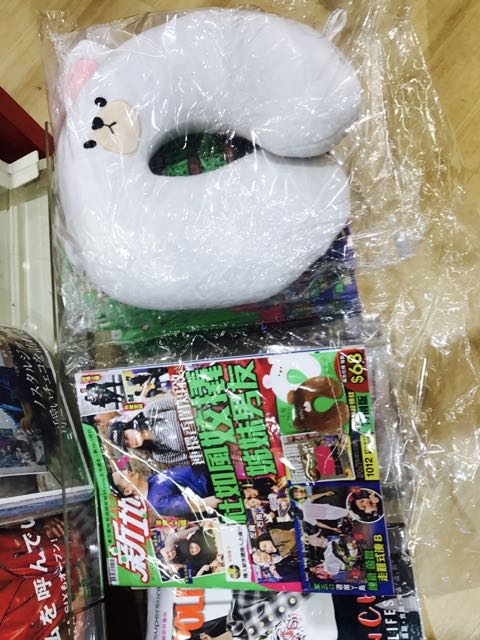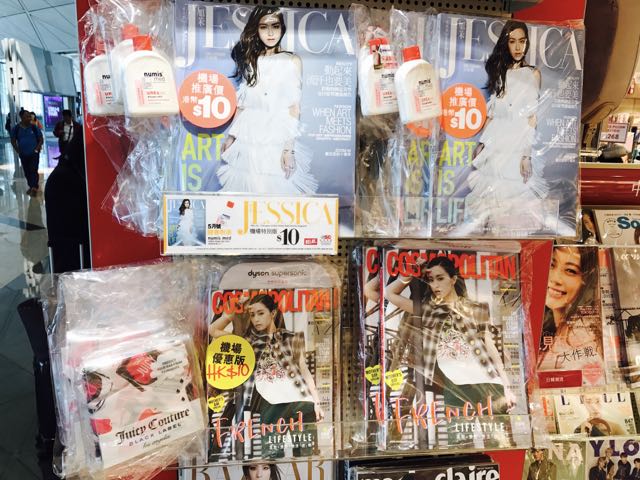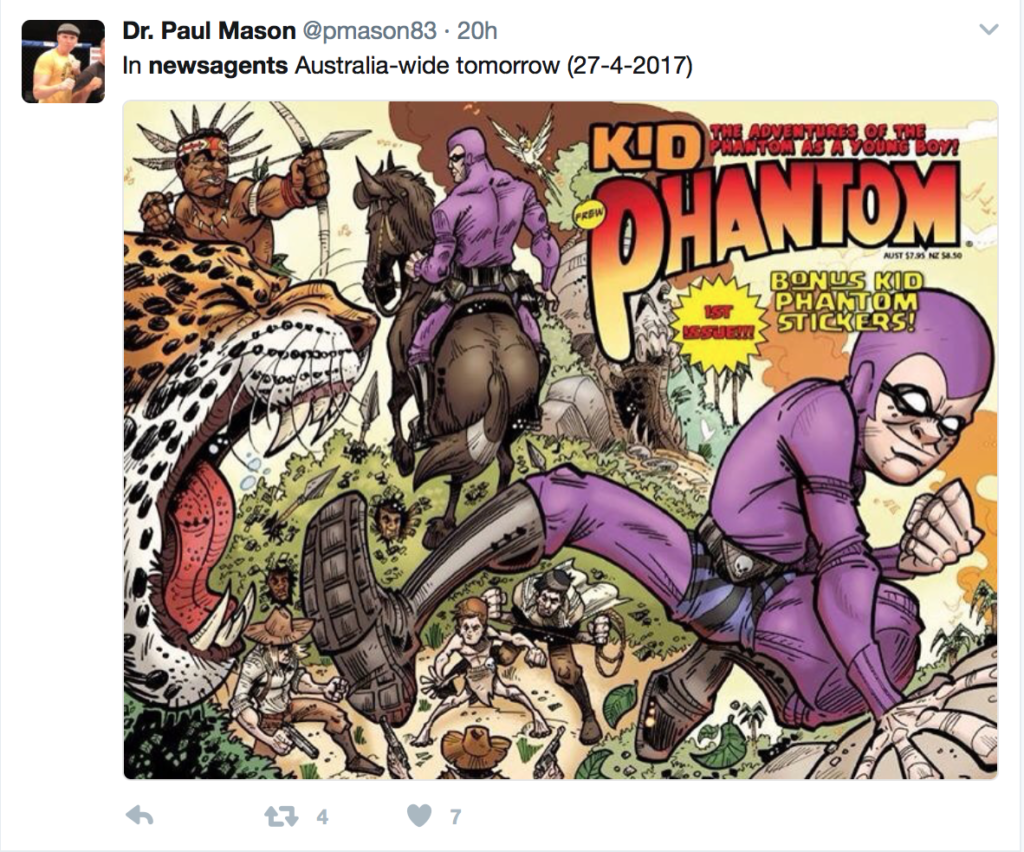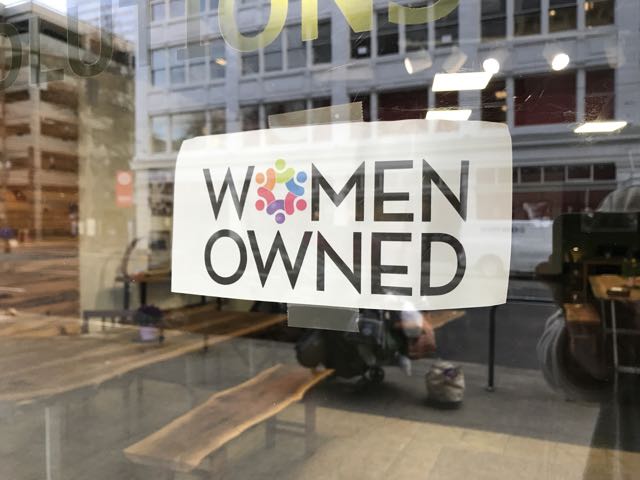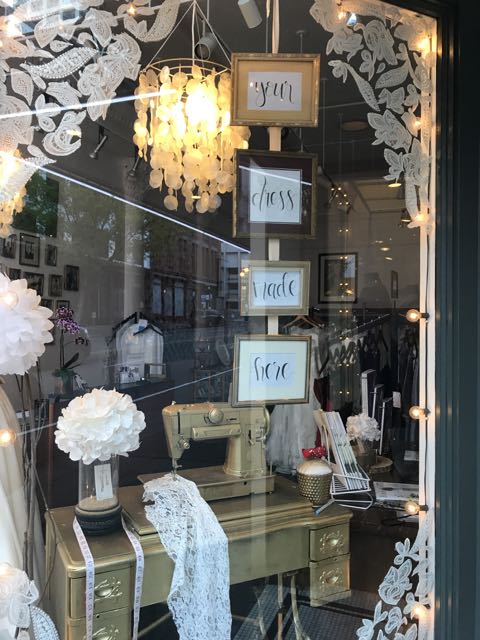The importance of exclusive products for small business retailers
 Having access to exclusive products is key to differentiation for any business. In the supermarkets they use home brands to achieve this while major toy, homewares and gift businesses buy in bulk products exclusive to their banner.
Having access to exclusive products is key to differentiation for any business. In the supermarkets they use home brands to achieve this while major toy, homewares and gift businesses buy in bulk products exclusive to their banner.
Typo is a good example of an exclusive focussed business. Almost all of what they sell in Typo brand. While you can get similar elsewhere, for Typo the products are tweaked in a way to make then a genuine exclusive.
Exclusivity means price comparison is harder. It also means you can play with your offers in a way that benefits your margin. Take a careful look at Typo and you will see how they do this.
Kikki.k is another store that sells its own products – for all the reasons noted above.
I have been in Hong Kong at the gift fair this weekend, looking at products for newsXpress. At this fair, talking with buyers from major retail groups, the value of exclusivity was reinforced in a brutal way.
On one stand a small business retailer with six shops was looking at a new hot product at the same time a buyer was from a national retailer from the same country. The national retailer buyer was able to commit to purchasing one hundred times the small business retailer could commit to. In return, the buyer sought, and was given, exclusivity.
In this world of borderless retail, having products that no one else has is important. The best way to achieve this is to be as close as possible to the source of the products.
This is a big challenge for retailers who buy by themselves from everyday wholesalers.
It is also a big challenge for banner groups that don’t attend the international trade shows to access new products before their usual local wholesalers have the products in their catalogues.
Exclusivity can be accessed in a number of ways. The best approach depends on the product line and the supplier attitude to exclusivity. I have seen it work well in a range of categories, where exclusive products have been key in driving net new traffic for the the engaged retailers.
Getting the exclusive product is the start, next comes the in-store pitch, out of store marketing and commitment of all involved to make it work.
Sunday newsagency marketing tip: be an outlet for local artists
 Find a wall in your shop and turn it into a mini gallery space for local artists. Make it available at no cost. Choose artists based on what you think works best.
Find a wall in your shop and turn it into a mini gallery space for local artists. Make it available at no cost. Choose artists based on what you think works best.
You will help local artists and better connect you with the community.
The photo is from a shop I was in two weeks ago. On the wall they had a small showing of photos taken by a local young photographer. There was nothing commercial about it.
To me, this idea is a not brainer for any regional, rural or high street independent retail business. The more we support our local community the more likely the local community will support us.
The added benefit is the beauty you can bring to the shop.
Be a force for good: support local artists and give locals another reason to visit your business.
Sunday newsagency management tip: dig for gold in your card data
Greeting card sales data offers newsagents terrific guidance on what gifts to stock. Dig deep into the data and you will be equipped to make better quality decisions on what gifts to stock in the business.
I was talking to a newsagent last year who said they could not sell male gifts. They did not have any in the shop. It turned out they had not had any in the ten years the current owner had owned the business. In their card data, plenty of male birthday cards were being purchased. A quick dig provided demographic and other information.
Greeting card sales data in a newsagency business is one of the best resources to mine if you want to grow gift sales.
Magazines in specialty retail
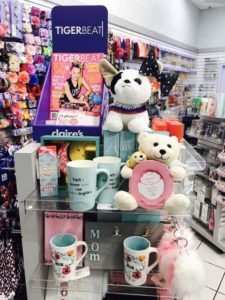 In the US last week I saw Tiger Beat magazine in several Claire’s stores. Claire’s is a value-based fashion store targeting girls 8 through around 15.
In the US last week I saw Tiger Beat magazine in several Claire’s stores. Claire’s is a value-based fashion store targeting girls 8 through around 15.
This was the first time I had noticed a magazine in a Claire’s. So, I suspect this is a publisher arrangement or promotion.
It makes sense when you think about it, pitching a special interest title in a retail chain that perfect fits with the demographic you are targeting.
I have seen this plenty in overseas retail in the last year – magazines in specialty retail situations where you would not in the past have seen magazines. While I am not aware of it being widespread in Australia I suspect we will see it as magazine publishers explore other go to market strategies through which they can reach their target reader.
Newsagents are effectively encouraging magazine publishers to consider alternative routes as we continue to dilute our commitment to the category. I note we are doing this with good cause – poor margin, a challenging supply model, increasing labour and retail space costs – all making the category less appealing than ever.
As we diversify our businesses I think we can be more specialised in our magazine offering. However, it is hard work to achieve this given the current model.
Good on Claire’s for pitching Tiger Beat. You can tell from then placement they consider it to be an ideal title with which to signpost the store. Each shop I visited had the stand in the same location – just inside the door.
News Corp. Play Doh promotion offers newsagents little incentive
 I have been contacted over the last two days by several Queensland distribution newsagents this week about the Play-Doh promotion being run next month by News Corp. promoting their Courier Mail newspaper.
I have been contacted over the last two days by several Queensland distribution newsagents this week about the Play-Doh promotion being run next month by News Corp. promoting their Courier Mail newspaper.
This blog post is for them.
The main complaint is the meagre margin of 11 cents per item sold. Distribution newsagents receive this eleven cents for handling the promotional product. This will not cover labour, space and shrinkage in handling the product.
While News Corp. will say the pay-off for newsagents is increased sales, I doubt the company would accept that response if a supplier of theirs used the same argument. Indeed, given the slim margin for newspapers the bump i sales would have to be extraordinary to make the promotion profitable.
News Corp. needs to listen to newsagents on promotions like this. The old school way of doing things, as is reflected in the promotion, is not appropriate to today. In fact, it disrespects newsagents.
When a supplier expects a newsagent to provide labour to support the supplier business they need to compensate the small business newsagent fairly. Newsagents have no capacity to hire staff to work for as little as News Corp. is paying for this promotion.
Recasting the image and appeal of the newsagency
We are preparing to open a business a new location in a high street situation in suburban Melbourne.
As part of the process of preparing the business we have been looking at our messaging inside and outside the shop. We wanted messaging that reflected the style and emotion of the business.
Here is art we are using for the first three months. I say three months as we will be chasing the art regularly.
This poster will run across the lower part of the front window, facing the street, as well as inside the store. It is not the only positioning collateral we are using. I will save those photos for another time.
While trading under a brand, major international product brands feature on the shingle and elsewhere in the business. These, coupled with the emotion-focussed posters above, pitch the business in a fresh way and in my view a better way than a newsagency shingle would.
The shop itself was a card shop until the owner put it into administration just before easter. We had a day to make a decision and move, which we did, acquiring the business from the administrator. The shop will open sometime next week and evolve over the next few months as we play with fresh ideas before we settle on what the model actually looks like.
This will be a hybrid business. It has no lotteries or tobacco products and will only have limited papers and magazines. The shop will primarily offer cards, gifts and collectibles.
What I am doing here, investing in a new retail location, reflects my optimism for the channel, regardless of the shingle under which businesses trade.
Here is a way to find out the magazines your customers want you to stock
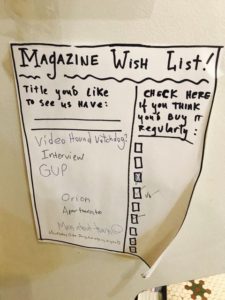 I like this sign I noticed in a magazine shop I visited last week. I like it for several reasons: it shows shoppers the business can get more titles than are currently stocked, it involved the customers in the process and, it shows the business acting as a place that cares about magazines.
I like this sign I noticed in a magazine shop I visited last week. I like it for several reasons: it shows shoppers the business can get more titles than are currently stocked, it involved the customers in the process and, it shows the business acting as a place that cares about magazines.
These are all important factors if you see yourself as a magazine specialist, or at least a retailer doing a better job with magazines than supermarkets.
I have used signs before but not one like this. I think I will give it a go.
I know of newsagents who comb the list of titles available from Gotch and request what they think might work. I applied their initiative and action. But there has to be an easier way.
The poster in then image with this blog post is of itself not an answer either as it takes care of the customer side while on the supply side there continues to be a disconnect when it comes to us getting titles we think we can sell.
Why I think Tatts will be a challenge for retailers regardless of who owns the company
I don’t see any reduction in the challenges for lottery retailers from a change of ownership of Tatts Group.
While the company is clearly in play with reports last week about Kohlberg Kravis Roberts restating their desire for the company and the on-going pursuit by Tabcorp, I don’t see how an acquisition can improve the lot of retailers.
Let’s think this through. The successful suitor will need to demonstrate prospects for a good return for their share price to benefit … and driving share price is the single most important goal of any public company.
To drive share price they have to pursue value. Value is driven by efficient, friction-less, customer engagement. Efficient, friction-less, customer engagement for lottery purchases is about online, mobile to be more specific.
That game of in-store lottery purchase versus online is over. Online has won. Those who disagree don’t realise yet that online has won.
You only have to look at what people are purchasing online, how and when they purchase and the purchase volume.
That I can purchase lottery tickets in seconds and easily sign up for a subscription is what I as a shopper want. I am sure it is what many shoppers want. It is also what I would want to see from tatts if I was a shareholder.
Sure, there are plenty who like the trek to the shop, the banter at the counter, the manual ticket check and the re check in your shop. I think those people are diminishing in number.
Based on their tech investment, tatts thinks this too. So does Tabcorp based o their online and mobile tech investments.
The only thing that may change user a new owner is the capex requirement around in-store infrastructure. However they play it, it won’t be good news for retailers.
If you have lotteries i your shop and are hoping for a new owner to make things easier for you, I suggest you don’t wait. Rather, work today to make your business strong and diverse so it has a future without lotteries.
Tatts is talking down online at their current round of retailer briefings. They say online has plateaued.
 Here is the evidence on which Tatts relies to say online has plateaued. It is wrong to make the claim based on such limited data. You need to see the numbers a year and two years out. You also need deeper analysis of the data and not just the topline numbers they have released.
Here is the evidence on which Tatts relies to say online has plateaued. It is wrong to make the claim based on such limited data. You need to see the numbers a year and two years out. You also need deeper analysis of the data and not just the topline numbers they have released.
Sunday newsagency marketing tip: events are terrific traffic drivers
 In our retail businesses, with such a diverse mix of products and specialisations, we have wonderful opportunities for hosting closed-door events.
In our retail businesses, with such a diverse mix of products and specialisations, we have wonderful opportunities for hosting closed-door events.
Each event can target a special interest or a demographic niche that is of value to you. Each is an opportunity bring new people to your business.
This type of marketing activity is 100% on the retailer and not suppliers.
Sunday newsagency management tip: look at the right data
A newsagents I was speaking with recently expressed concern about sales. I took a look at their data and saw healthy numbers. Whereas they were looking at data for two weeks, I was looking at data for three months.
Comparing trading periods with less than two weeks data is dangerous. You need at least three months, preferably longer.
In my own businesses I look at three months and then compare over a longer period.
Anything shorter than three months can skew your perspective. Seasons, for example, can impact and this is heightened with a smaller data set.
Comparing the first six months of a year with the year before provides a cleaner, smoother analysis and this is what you need for uncovering real trends being experienced by the business. Looking at two weeks is dangerous.
Lottoland moves on competition and could be set to sponsor the Melbourne Cup
The Herald Sun has the story of Lottoland possibly sponsoring the Melbourne Cup. If this happens it will take awareness to a new level.
I can understand possible interest by Lottoland as theirs is a worldwide brand.
The speculation of the move comes on the heels of the move by Lottoland on Jumbo Interactive, an ASX listed company with a contract for online sales of Tatts products.
The AFR has the Lottoland Jumbo story.
Lotteries sector disrupter Lottoland has pounced on listed online lottery ticket seller Jumbo Interactive, as first reported by Street Talk.
A line of 2.25 million Jumbo Interactive shares changed hands after market on Wednesday at a 28 per cent premium to the market price.
This is a big move. On the ASX site today you can see notice re reduction in shareholding by the seller but not yet the notice for the buyer.
Lottoland is not going away folks. This company that mocks newsagents in their advertising appears set to win more lottery related revenue in Australia.
More Aussie magazine publishers should support newsagents online
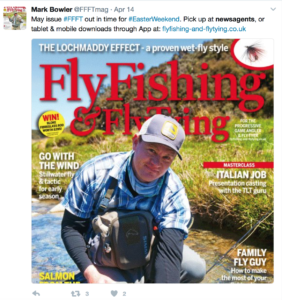 More UK magazine publishers support newsagents online than we see in Australia.
More UK magazine publishers support newsagents online than we see in Australia.
Tweets like you can see in the image are common – a UK publisher promoting the latest issue of their magazine and pitching availability in newsagents.
Tweets like this help drive vital in-store traffic.
Every publisher with magazines in newsagencies should be promoting the newsagency channel. The top two ways they can best do this are:
- Have a list of all retailers on their website. This needs to be on the home page, easily searchable and viewable by a map.
- Promote newsagents when every new issue is out, on Twitter, Facebook and elsewhere. With a link to the page from where people can find their local stockist.
Given the low margin for magazines, it is incumbent on magazine publishers to drive traffic to retail outlets if they want such outlets to continue to stock the low margin product.
Another thing publishers could do would be to provide retailers with easy access to social media friendly collateral that retailers themselves could use on their social media accounts. This needs to be content that meets the rules of the various platforms.
The magazine publishers that should engage with these ideas the most are those with their titles only in retail newsagency businesses. If they are in supermarkets too I don’t care as much. Titles exclusive to the newsagency channel are more niche and more interesting in terms of publishers leveraging their own communities to drive retail newsagency traffic.
What I suggest in this post costs nothing except for a small amount of time. The return should be worth it and would include appreciation from retailers you support.
Newsagents frustrated to receive Stationery News
I have been contacted by newsagents who received Stationery News magazine today and were billed for a full year subscription – when they did not subscribe.
This has been going on for at lest two years – newsagents being sent the title, unsolicited, with a charge to their magazine account with the distributor.
It takes time to fix and causes considerable frustration. Yet, no seems to be able to fix it permanently.
The experience is another magazine supply frustration that takes newsagent attention away from being better retailers.
Better planning needed to leverage new titles
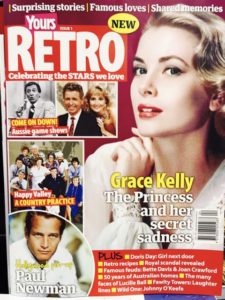 While I like Yours Retro, it is a pity there was not better advance communication well in advance so we could factor this new title into a broader retro display is we wished.
While I like Yours Retro, it is a pity there was not better advance communication well in advance so we could factor this new title into a broader retro display is we wished.
Whereas in the past a magazine launch would work in isolation, today it needs support from outside the category and engaged retailers can do that thanks to access to a broader range of products.
To support Yours Retro we have access to a wonderful range of retro products, including products for the era featured on the cover. However, leveraging such an opportunity takes time. Also, it has to be part of the marketing calendar. Not engaging us in advance loses the opportunity.
All magazine publishers need to understand where they fit in our world today. Whereas in the past the magazine was the destination purchase most of the time, that is no longer the case. Retailers get that. Plenty of us look for opportunities to support magazines in broader marketing initiatives in our businesses.
I get that publishers want to keep launched under wraps until the last minute. However, doing this denies and engaged retailer the opportunity to engage beyond doing only basic stuff.
Magazines are different for n newsagents and supermarkets. Where supermarkets see the magazine as a basket extension, newsagents have the potential to be more engaged. Achieving that requires publishers to be more engaged, beyond posters and a display competition as those things are so yesterday.
Vale Ken Murphy
Ken Murphy, former CEO of the Queensland Newsagents’ Federation, has passed away while overseas on holiday.
For many years at the QNF Ken was a fighter on behalf of Queensland newsagents. He was outspoken on matters of industry unification, poor national leadership and the Bill Express disaster that cost newsagents tens of millions of dollars.
After Ken left the QNF the weakened organisation failed to serve newsagents and it ultimately merged with the ANF. Those years after his departure reflect the loss of Ken’s service on behalf of newsagents.
Regardless of the side you took on any matter with Ken, you knew he was fighting for what he felt was right and fair for his members. Ken was missed when he left the QNF and will be missed more so on the hearing of this news.
Magazines work on the back wall of the business
Last week, just before Easter, we moved the magazine department from the body of the business to the back wall. Not as punishment, not out of frustration. No, we moved them as a result of careful thought and analysis and consideration of other uses of the magazine fixture we had on the shop floor.
At the back of the shop we have room for a more enjoyable shopper experience, more space to browse, more titles with full cover display, deep pockets to hold more copies of a title and a bette tier age solution for seeing the whole range we have in store.
The biggest challenge of the move is the need to draw people to the back of the shop. We are making that easier with good sight lines, good lanes to the back of the shop and clear signage.
We already had half our titles on the back wall, now we have all of them there in a more consistent display.
This move is the first of a series of shop floor moves that will enable us to expand in a couple of net new traffic driving product categories. It is like playing with the kids puzzle where you move plastic squares around to make a picture. The picture we have in mind is fresh and fun.
